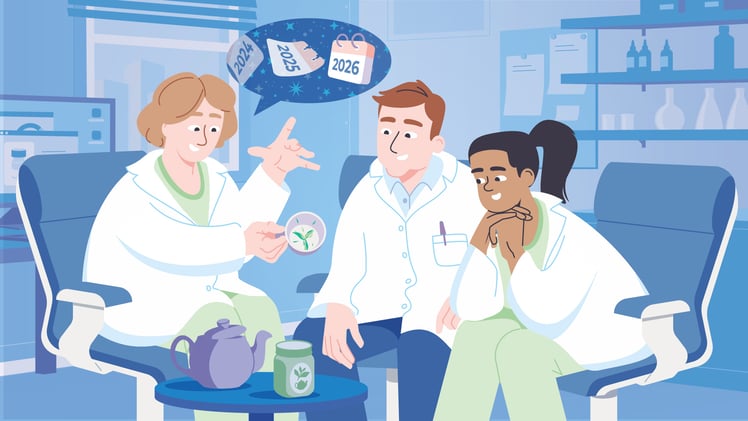Alternative Antibody Modalities
The Science Behind Next-Gen Therapies
The 2010s saw an explosion in the use of new, uncommon and sometimes novel antibody-based therapeutics. These modalities allowed for antibody drug design that goes beyond traditional monoclonal and polyclonal pathways.
The results have been extremely rewarding, as we’ve seen with new therapies that have hit the market and offered life-changing care options for many patients. In order for those drugs to be effective – let alone life-changing – they still need to be of optimal quality. Antibody Solutions can offer informed and straightforward guidance if your therapeutic falls into one of these alternative modalities.
Explore Alternative Modalities
We speak “antibody discovery” as a native language, and we’re always excited to add new words to our lexicon. Here’s a quick summary of some alternative modalities that may provide the ideal answer to your most pressing antibody discovery questions.
Single-Chain Antibody Fragments
Single-Chain Antibodies
This monoclonal antibody model has formed the backbone of many effective cancer treatments. Single-chain antibodies are typically formed by linking VH and VL domains of antibodies with a flexible peptide linker. Some cancer antibody therapies, using delivery methods such as a fusion peptide or nanoparticles, have been successfully deployed to targets like HER2 and other cells.
Single-Domain Antibodies
Single-Domain Antibodies
“Small, but mighty” is how we would describe these recombinantly produced, heavy chain IgG antibody fragments. Despite their robust structure and specificity, nanobodies are flexible enough to address a broad range of in vivo and display project formats. They are highly durable, allowing them to modulate tricky sets of intracellular receptor signals, and their small size makes them ideal for accessing hard-to-reach cell cavities.
Antibody Drug Conjugates (ADCs)
Antibody Drug Conjugates (ADCs)
Antibody Solutions has had the privilege of taking on multiple ADCs projects. This relatively new model of antibody has proven itself to be extremely effective, with their use showing up successful approved therapies that target cancer and autoimmune diseases. The ADC structure consist of three major parts: a monoclonal antibody, a toxic payload (usually a cancer-killing drug) and a flexible peptide linker that keeps the two connected. ADC treatments are ideal for delivering small but highly targeted therapy that attack targeted cells effectively while not exceeding a level of toxicity that is tolerable to the patient.
Chimeric Antibodies
Chimeric Antibodies
While chimerics don’t always make it to the approval stage on their own, they can be very useful as intermediates in the humanization stage and can be instrumental in the development of critical reagents. Chimeric antibodies are a valuable option for in vivo research and developing stable cell lines.
T-Cells
T-Cells
Next-gen cancer and virus treatments are starting to cross all the “t’s” in cell therapy – tumor-infiltrating lymphocyte (TIL) therapies, engineered T cell receptor (TCR) therapies, and, perhaps most notable, chimeric antigen receptor (CAR) T therapies. They’ve proven effective, in particular, against aggressive cancers (including lymphoma, leukemia, and multiple myeloma). While comparatively new treatment forms, they’re still reliant on many of the same skills that have been used to engineer traditional antibody models. Our experienced team can help you make well-informed and cost-effective choices if you’re looking to dip your toe into these promising new waters.
Bispecifics
Bispecifics
The unique character of bispecific antibodies to engage multiple targets simultaneously is providing a fresh blueprint for treating diseases with complex biological pathways. As with any emerging modality, though, that opportunity comes with an inherent cost; in this case, their multipurpose nature makes bispecifics susceptible to challenges regarding stability, manufacturing, and immunogenicity, among others. With our years of experience and depth of expertise, we can help you navigate the tricky path of bispecific discovery.
Single-Chain Antibodies
This monoclonal antibody model has formed the backbone of many effective cancer treatments. Single-chain antibodies are typically formed by linking VH and VL domains of antibodies with a flexible peptide linker. Some cancer antibody therapies, using delivery methods such as a fusion peptide or nanoparticles, have been successfully deployed to targets like HER2 and other cells. Uses of siRNAs include treatments for inflammatory bowel disease (IBD), avian influenza virus (H5N1), and pain management.
Single-Domain Antibodies
“Small, but mighty” is how we would describe these recombinantly produced, heavy chain IgG antibody fragments. Despite their robust structure and specificity, nanobodies are flexible enough to address a broad range of in vivo and display project formats. They are highly durable, allowing them to modulate tricky sets of intracellular receptor signals, and their small size makes them ideal for accessing hard-to-reach cell cavities.
Antibody Drug Conjugates (ADCs)
The makings of an effective antibody drug conjugate (ADC) – an antibody-based therapy that targets cancer-causing cells – require a carefully balanced combination of an antibody to the target, a cytotoxic drug (payload), and a linker connecting the two. ADCs provide an ideal solution against previously undruggable targets, but demand expertise in the discovery of antibodies to tumor targets, conjugations with linker-toxins, and the evaluation of cell killing, among other specialities. (Get a more thorough analysis of the current state of “magic bullet” ADCs here.)
Chimeric Antibodies
While chimerics don’t always make it to the approval stage on their own, they can be very useful as intermediates in the humanization stage. The high affinity and specificity of chimeric antibodies make them a valuable option when creating antigens for in vivo research and in developing stable cell lines.
T Cells
Next-gen cancer and virus treatments are starting to cross all the “t’s” in cell therapy – tumor-infiltrating lymphocyte (TIL) therapies, engineered T cell receptor (TCR) therapies, and, perhaps most notable, chimeric antigen receptor (CAR) T therapies. They’ve proven effective, in particular, against aggressive cancers (including lymphoma, leukemia, and multiple myeloma). While comparatively new treatment forms, they’re still reliant on many of the same skills that have been used to engineer traditional antibody models. Our experienced team can help you make well-informed and cost-effective choices if you’re looking to dip your toe into these promising new waters.
Bispecifics
The unique character of bispecific antibodies to engage multiple targets simultaneously is providing a fresh blueprint for treating diseases with complex biological pathways. As with any emerging modality, though, that opportunity comes with an inherent cost; in this case, their multipurpose nature makes bispecifics susceptible to challenges regarding stability, manufacturing, and immunogenicity, among others.
Explore Opportunities With a Trusted Collaborator
For researchers feeling the constraints of traditional approaches to antibody discovery or merely curious about new trends, this may be the ideal time to explore alternative modalities. In other words, this may be the time to contact Antibody Solutions. We’ll help you assess whether these modalities can move you closer to your research goal.
Related Resources

12 min read
Reading the Biotechnology Tea Leaves: Therapeutic Antibody Developments in 2023 and 2024
With its “Antibodies to Watch” publication, The Antibody Society provides a comp...

9 min read
With Its Latest Prominent Variant, SARS-CoV-2 is Up to Its Old Tricks
Antibody Solutions has been tracing the evolution of SARS-CoV-2 from the earlies...
14 min read
Looking Into the Future: Therapeutic Antibody Trends
Although Antibody Solutions focuses primarily on therapeutic antibody discovery ...
